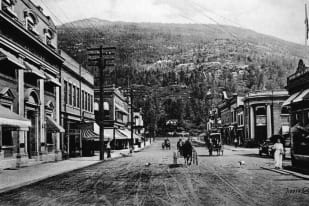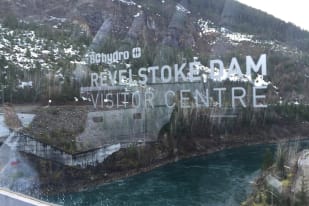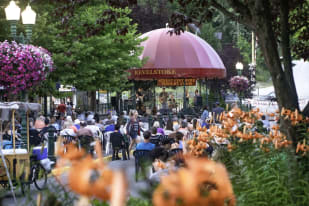Revelstoke Railway Museum and the Last Spike: The Railway That Built a Town

The Revelstoke Railway Museum is more than a collection of artifacts. It tells the story of how rail shaped an entire community and why that connection still matters today. Trains didn't just pass through Revelstoke—they transformed it. The town became a key stop on the Canadian Pacific Railway (CPR), bringing workers, industry, and a culture built around rail travel. Today, the museum preserves that history with exhibits that let visitors experience the sights, sounds, and mechanics of rail travel in ways few other places can.
The CPR changed the course of Canadian history, and Revelstoke played a central role. The railway brought settlers, commerce, and development to the region, and the museum brings those stories to life through restored locomotives, interactive displays, and historical records. Few places offer such a hands-on connection to Canada's early transportation network.
A Museum Built by the Tracks
Established in 1993, the Revelstoke Railway Museum was created to preserve and share the stories of the people who built and operated the railway in this part of Canada. The museum's exhibits focus on the challenges of rail construction, the evolution of locomotive technology, and the lives of railway workers. The building itself is located near the original CPR line, reinforcing the close link between Revelstoke and the rail industry.
The collection includes everything from full-size locomotives to tools used by track workers. Photographs, documents, and personal artifacts paint a picture of what life was like for those who kept the railway running. The museum also highlights the engineering feats that made the CPR possible, including the construction of snowsheds, tunnels, and bridges that allowed trains to pass through the Selkirk and Monashee Mountains.
The Challenges of Railway Construction
Building the Canadian Pacific Railway through British Columbia was a monumental task. The terrain was among the most difficult in the country, featuring steep grades, dense forests, and unstable rock formations. Engineers had to design and build numerous snowsheds, tunnels, and bridges to make the railway functional year-round.
One of the most challenging sections was Rogers Pass, an area notorious for deadly avalanches. In 1910, one of Canada's worst railway disasters occurred here when an avalanche struck a crew clearing snow from the tracks, killing 62 workers. To combat this ongoing threat, the railway eventually constructed a tunnel under Rogers Pass, completing it in 1916 to ensure safer passage for trains.
The workers themselves faced harsh conditions. Thousands of labourers, including a significant number of Chinese railway workers, endured backbreaking labour for minimal pay. They blasted through rock, laid tracks by hand, and worked in extreme weather conditions. Many lost their lives due to accidents, landslides, and exposure. Their contributions were crucial in completing the railway, yet they were often met with discrimination and poor living conditions.
Despite these obstacles, the completion of the CPR in 1885 created an essential link between eastern and western Canada, fostering economic growth and national unity.
What to Expect at the Museum
The museum is designed to engage visitors of all ages. Some of the most popular exhibits include:
Steam Locomotive 5468
Built-in 1948 by the Montreal Locomotive Works, No. 5468 served primarily in Western Canada, hauling both freight and passenger trains across the challenging terrains of British Columbia. Locomotive 5468 is a P-2k class 2-8-2 steam engine featuring two leading wheels, eight driving wheels, and two trailing wheels. This configuration, known for its balance of speed and traction, made it well-suited for the steep grades and tight curves of the region's railways.
After its retirement, No. 5468 was preserved and became a centrepiece at the Revelstoke Railway Museum. The locomotive has undergone extensive restoration to maintain its historical integrity, allowing visitors to appreciate the engineering marvels of mid-20th-century steam technology.
The Diesel Locomotive Simulator
The diesel locomotive simulator is a must-try for those curious about modern rail travel. The experience gives visitors a feel for what it takes to operate a train through mountainous terrain. The controls, gauges, and response of the engine replicate what real train engineers manage every day.
Archives and Artifacts
The museum's collection of photographs, documents, and personal belongings from railway workers provides insight into the lives of the people who kept the trains running. Letters, logbooks, and uniforms help paint a picture of railway life, from the dangers of track maintenance to the discipline required to operate the locomotives.
Museum Events and Programs
Throwback Thursdays
Every Thursday, the museum extends its hours until 8 PM and offers a 50% discount on admission. This initiative encourages visitors to explore the exhibits during the evening and participate in special events or programs that may be scheduled.
Special Exhibitions and Workshops
The museum periodically hosts special exhibitions focusing on railway history and technology aspects. Workshops and interactive sessions are also organized for enthusiasts and scholars. Details about upcoming events can be found on the museum's official website.
Visitor Information
Admission Prices
The Revelstoke Railway Museum offers the following admission rates (plus applicable taxes):
Adults: $14
Seniors (60+): $12
Youth (13-18): $8
Children (6-12): $4
Children 5 & Under: Free
Family (up to 5 members): $30
Members receive free admission. Support workers accompanying visitors also enter for free. Group rates are available for parties of 10 or more.
Hours of Operation
The museum operates on the following schedule:
Thursday: 10 AM – 8 PM
Friday to Sunday: 10 AM – 6 PM
Monday to Wednesday: Closed
It's advisable to check the museum's official website for any updates or seasonal changes before planning your visit.
Accessibility
The museum is wheelchair accessible, ensuring all visitors can comfortably explore the exhibits.
Visitor Guidelines
To ensure an enjoyable experience for all visitors, the Revelstoke Railway Museum has established the following guidelines:
Behaviour: Please enjoy the exhibits respectfully. Avoid loud or disruptive actions. Verbal or physical abuse toward staff or other visitors will result in removal from the premises.
Exhibit Interaction: Unless signage indicates otherwise, refrain from touching artifacts, climbing on displays, or sitting on exhibit cases.
Smoking and Substance Use: Smoking and vaping are prohibited throughout the museum and within heritage railway equipment. Consumption of alcohol and recreational cannabis is not allowed on the property.
Attire: Shirts and shoes are required at all times. Swimwear or clothing with offensive content is not permitted.
Solicitation: Soliciting in any form is not allowed within the building or on museum grounds.
Pets: Only service dogs are permitted inside the museum. Do not leave pets unattended in vehicles, especially during warm weather. For pet boarding options, contact the Revelstoke Visitor Centre.
Food and Drink: With the exception of water and baby bottles, food and beverages are not allowed inside the museum. Visitors can enjoy picnics on the outdoor grounds but must dispose of litter properly.
Photography: Non-commercial photography is encouraged. However, please be considerate of other guests and note that tripods are not permitted in the galleries.
Children: Those under 12 years old must be accompanied by an adult at all times within the museum and during public programs.
Drones: The use of drones or other aerial vehicles is not permitted inside the museum or over its property without written consent from the museum director.
By adhering to these guidelines, visitors contribute to a welcoming and safe environment for everyone.
The Last Spike: More Than a Symbol
The Revelstoke Railway Museum is just a short drive from Craigellachie, BC, the site of The Last Spike. This is where, on November 7, 1885, the final spike of the Canadian Pacific Railway was hammered into place, completing the transcontinental railway.
The Last Spike wasn't just a ceremonial gesture—it marked the end of a massive undertaking that connected Canada from coast to coast. The railway linked eastern and western provinces, secured trade routes, and fulfilled a promise made to British Columbia when it joined the Confederation in 1871.
The Craigellachie Historic Site features a commemorative plaque, a replica of the original spike, and interpretive signage explaining the significance of this moment in Canadian history. Visitors often stop at both the site and the museum to get a full picture of how the railway shaped the country.
Why Revelstoke Still Matters to Rail Travel
Revelstoke is still an active railway town. Freight trains continue to pass through, carrying goods across Canada. The town is also home to railway workers and families with multi-generational ties to the CPR. The museum keeps this history relevant by educating visitors about the past while connecting it to the present.
Beyond its role in rail history, Revelstoke offers outdoor activities, scenic landscapes, and a welcoming community that embraces its connection to Canada's railway heritage. The museum serves as a reminder that the railway isn't just about the past—it's a story that continues today.
Experience the Railway for Yourself
The Revelstoke Railway Museum is one of the best places in Canada to experience railway history up close. The locomotives, exhibits, and archives bring the past to life, showing how the railway shaped a town and a nation.
Visitors looking for a full railway experience can combine their trip to the museum with a visit to The Last Spike at Craigellachie. Whether you're interested in engineering, history, or the personal stories of railway workers, this museum delivers a unique and informative experience that stays with you long after you leave.




